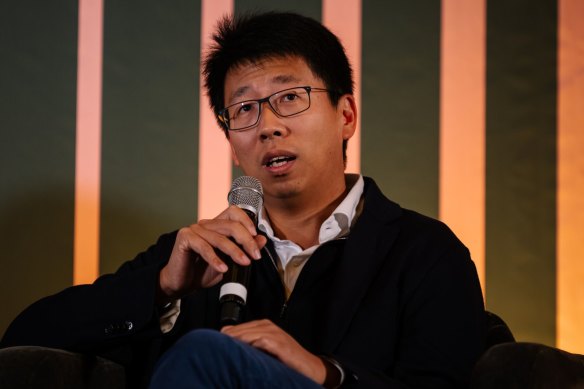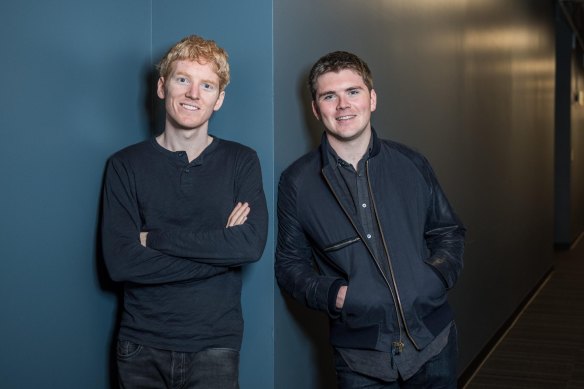

Jack Zhang, co-founder and chief executive officer of Airwaller, says Australia will be cashless within 10 to 20 years.Credit: Bloomberg
“I have travelled to 30 countries this year, and I’ve had no cash whatsoever. I’ve never needed to use it.”
Airwallex, which was most recently valued at $US5.5 billion in late 2022, knocked back a billon-dollar takeover bid from Stripe in 2018, an offer Zhang now says was not about money. Collison declined to comment.
Statistics from Australia’s largest bank CBA back up Stripe and Airwallex’s assertions. Its customers withdraw 51 per cent less cash from ATMs now than they did in 2019, and make 85 per cent more of their payments digitally than they did five years ago.
In the last year, Australians made $126 billion in payments with their mobile wallets, overtaking total ATM cash withdrawals for the first time ever.
“While the vast majority of payments across Australia are now made via card and digital means, many people still want access to cash. Cash is, and will remain, an important part of the economy,” Angus Sullivan, the bank’s group executive in charge of retail banking, told this masthead.
Loading
“We spend around $400 million a year to support the distribution of cash across Australia and we are committed to making sure cash is available to our customers who need it.”
There are concerns that vulnerable Australians would be most affected by a shift away from notes and coins, with lobby group CashWelcome.org arguing that moves by banks to limit access to cash could leave millions of vulnerable people stranded.
Collison said however that India and China are strong examples of near-cashless economies that have successfully looked after their most vulnerable in the process.
Cash is also getting more expensive to move and distribute: cash transit business Armaguard in June received a $50 million bailout from big banks, retail giants and Australia Post after warning its future was at risk.
Another serious concern is resiliency, and that an overreliance on technology for payments will leave business and consumers exposed in the event of a mass outage, like the recent CrowdStrike incident that crippled supermarkets and businesses globally. Some estimates put the damage bill from the outage at more than $1 billion in Australia alone.
“With a business operating at scale, it is fundamentally reliability that matters,” Collison said.
“We spend enormous amounts of effort and attention on this, making sure we have geographically redundant data centres so that an earthquake someplace would not interrupt processing.
“We just approved a significant unnecessary expenditure this year in order to further enhance our reliability. That’ll make our 2024 financials look very slightly worse, but we think it’s just the right thing to do given the position we occupy.
“These fundamental infrastructure platforms have to operate with that attitude.”

Stripe founders and brothers Patrick and John Collison used payment orchestration to create a fintech worth billions.
Over the past decade, Australia has built a strong pedigree in fintech and payments innovation, birthing Airwallex as well as fellow heavyweights Afterpay and Zip.
For Collison, Australia is punching above its weight in fintech just as it did in the Paris Olympics.
“If you look at it on a per capita basis, I feel like the US actually punches below its weight, and everywhere else punches above, and Australia is a good example of that,” Collison said.
Loading
“Australia is a savvy, sophisticated, well-educated and digitally adept. Maybe there’s something about the distances that almost force the country to adapt quickly, and to take advantage of things like the internet and e-commerce. There is clearly something innately entrepreneurial about folks here, I mean Atlassian and Canva are two of the most successful software companies in the world and they were founded here.”
Patrick Collison started Stripe with his brother John in 2010, with the pair re-locating from Ireland to California to secure venture capital funding for their start-up, which is currently dual-headquartered in San Francisco and Dublin. In 2016, they became the world’s youngest self-made billionaires.
Patrick said he would not hesitate in recommending anyone starting a business with their brother.
“There’s the idea that you shouldn’t work with your friends. I think that’s a conspiracy to deprive people of some of life’s most fulfilling experiences,” he said.
“I think work with your friends, work with your family, it’s amazing.”
The reporter travelled to Stripe Tour as a guest of Stripe.
Get news and reviews on technology, gadgets and gaming in our Technology newsletter. Sign up to receive it every Friday.



























